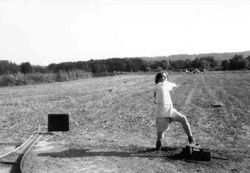
Field hockey is a team sport structured in standard hockey format, in which each team plays with 11 players in total, made up of 10 field players and a goalkeeper. Teams must move a hockey ball around a field by hitting it with a hockey stick towards the rival team's shooting circle and then into the goal. The match is won by the team that scores the most goals. Matches are played on grass, watered turf, artificial turf, or indoor boarded surface.

Kabaddi is a contact team sport played between two teams of seven players Traditional games of South Asia. The goal of the game is for a single offensive player, called the "raider," to enter the opposing team's half of the court, tag as many players as possible, and return to their own side within 30 seconds, all while avoiding being tackled by the defenders. Points are scored for each player tagged by the raider, while the opposing team earns a point for stopping the raider. Players are taken out of the game if they are touched or tackled, but return to the game after each point scored by their team from a tag or tackle.
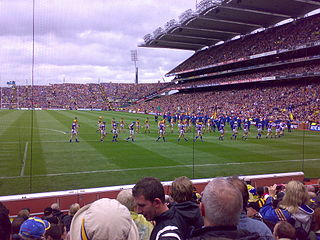
Hurling is an outdoor team game of ancient Gaelic Irish origin, played by men and women. One of Ireland's native Gaelic games, it shares a number of features with Gaelic football, such as the field and goals, the number of players and much terminology. The same game played by women is called camogie, which shares a common Gaelic root.

Real tennis – one of several games sometimes called "the sport of kings" – is the original racquet sport from which the modern game of tennis is derived. It is also known as court tennis in the United States, royal tennis in England and Australia, and courte-paume in France. Many French real tennis courts are at jeu de paume clubs.

Sepak takraw, or Sepaktakraw, also called buka ball, kick volleyball or foot volleyball, is a team sport. It is played with a ball made of rattan or plastic between two teams of two to four players on a court resembling a badminton court. It is similar to volleyball and footvolley in its use of a rattan ball and players using only their feet, knees, shoulders, chest and head to touch the ball. Sepak Takraw is often referred to as a mixture of volleyball, due to its use of a net, and association football, as players use their feet.

Schwingen, also known as Swiss wrestling and natively as Hosenlupf, is a style of folk wrestling native to Switzerland, more specifically the pre-alpine parts of German-speaking Switzerland. Wrestlers wear Schwingerhosen with belts that are used for taking holds. Throws and trips are common because the first person to pin his or her opponent's shoulders to the ground wins the bout.
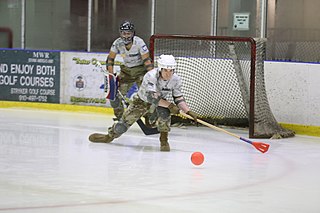
Broomball is a both a recreational and organized competitive winter team sport played on ice or snow and is played either indoors or outdoors, depending on climate and location. It is a ball sport and is most popularly played in Canada and the United States.

Tchoukball is an indoor team sport, played by teams of 7 players. It was developed in Switzerland in the 1970s, and is most popular in Singapore, Switzerland and Taiwan, but has become an international sport with national federations in over 60 countries. It is governed by the International Tchoukball Federation (FITB), which was founded in 1971.

Oină is a Romanian traditional bat-and-ball game, similar in many ways to baseball.

Kho kho is a traditional South Asian sport that dates to ancient India. It is the second-most popular traditional tag game in the Indian subcontinent after kabaddi. Kho kho is played on a rectangular court with a central lane connecting two poles which are at either end of the court. During the game, nine players from the chasing team are on the field, with eight of them sitting (crouched) in the central lane, while three runners from the defending team run around the court and try to avoid being touched. Each sitting player on the chasing team faces the opposite half of the field that their adjacent teammates are facing.

Cycle polo, bicycle polo, or bike polo is a team sport, similar to traditional polo, except that bicycles are used instead of horses. There are two versions of the sport: Hardcourt Bike Polo and grass court bike polo. The hardcourt game saw a sharp spike in interest in the first decade of the 21st century and new teams are sprouting up across the world in China, Canada, Ireland, Switzerland, France, India, Germany, Pakistan, Ukraine, Russia, Malaysia, Sri Lanka, Indonesia, Hungary, Australia, New Zealand, Sweden, England, Scotland, Argentina, Italy, Spain, United States, Poland, Croatia, Slovenia, Lithuania, Nepal, Brazil and Cuba.
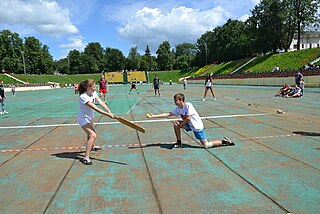
Lapta is a Russian folk game of the bat-and-ball type, first known to be played in the 14th century.
The 2006 Basel hooligan incident occurred on 13 May 2006 in Basel, Switzerland. On that day hooligans supporting the Swiss football club FC Basel 1893 stormed the field of St. Jakob-Park after a championship-deciding match against FC Zürich. Zürich scored in the dying moments of the match and won 2–1. The goal ended a chance for Basel to win the Swiss Super League for a third time in a row. This resulted in property damage and riots between hooligans of both teams' supporters after the match, an incident considered one of the worst incidents involving hooliganism in Swiss sport to date. 115 people, including police, were injured, with 15 hospitalizations.
Several sports related to volleyball have become popular. Indoor volleyball and beach volleyball are both events at the Olympics, and sitting volleyball is an event at the Paralympics. Other varieties are localized, or are played at an amateur or informal level.

Kin-Ball is a team sport created in Quebec, Canada, in 1986 by Mario Demers, a physical education professor.

Nine-pin bowling is a bowling game played primarily in Europe. European championships are held each year. In Europe overall, there are some 130,000 players. Nine-pin bowling lanes are mostly found in Austria, Czech Republic, Slovakia, Belgium, Germany, Luxembourg, the Netherlands, Estonia, Switzerland, Serbia, Slovenia, Croatia, Poland, North Macedonia, Hungary, France, Brazil and Liechtenstein.

Wheelchair football is a variation of gridiron football played in wheelchairs.
The FC Basel 1898–99 season was their sixth season since the club's foundation on 15 November 1893. This was the first season in which they competed for the Swiss championship. The club's chairman was Charlie Volderauer, who was chairman between 1896 and 1900. He was the third chairman in the club's history, following Roland Geldner (1893–1896) and Emanuel Schiess (1896). FC Basel played their home games in the Landhof, in the Quarter Kleinbasel.
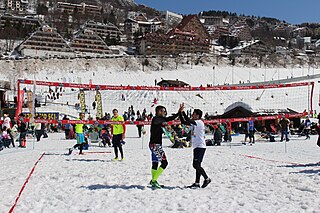
Snow volleyball is a winter team sport played by two teams of three players on a snow court divided by a net. The objective of each team is to score points by sending a ball over the net so as to ground it on the opponent's court, and to prevent the same effort by the opponent. A team is allowed up to three touches to return the ball across the net, and individual players may not touch the ball twice consecutively.
The 2013–14 IIHF European Women's Champions Cup was the tenth holding of the IIHF European Women Champions Cup (EWCC). Russian team Tornado Moscow Region of the Russian Women's Hockey League won the tournament for the third consecutive time and the fourth time in five years. With their victory, HK Tornado tied AIK Hockey for most EWCC titles won by a single club.

